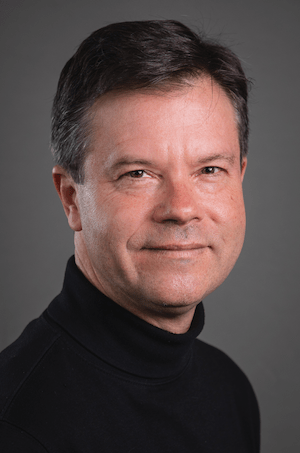Scaling your Social Enterprise – While Handling your Success: A Q&A with Microfinance Pioneer Alex Counts
It’s fair to say that few people have played a bigger role in the evolution of microfinance than Alex Counts. A truly seminal figure in the sector, he began his international development career at Grameen Bank, training under microfinance founding father and (later) Nobel laureate Muhammad Yunus. In 1997, Yunus provided him with $6,000 in seed funding to found Grameen Foundation, with the goal of replicating Grameen Bank’s model through a global network of microfinance institutions. By the time Counts left the organization in 2015, it was generating $20 million in annual revenue, with over 200 employees in eight countries.
While guiding Grameen Foundation through its own impressive growth, Counts became a passionate defender of the broader microfinance sector, as it evolved from its modest origins in Bangladesh to become a global industry with around 140 million clients and a credit portfolio of over US $110 billion. With scale came greater funding, media attention – and eventually controversy, as research sparked questions about the true anti-poverty impact of microloans. But throughout the turbulence, Counts has remained a clear-eyed and sharp-tongued defender of the industry, penning multiple books and articles, and remaining active in both financial inclusion and other development work.
NextBillion caught up with him on the occasion of the publication of his latest book, “Changing the World Without Losing Your Mind.” Besides offering a ringside view of the tumultuous growth of both Grameen Foundation and the microfinance movement, the book provides some of the most useful (and personal) advice we’ve read for social impact leaders facing the opportunities and obstacles of scale – including the unique challenges that come with success. Starting tomorrow, you can read a key chapter of the book in NextBillion Notes – subscribe here to get access to the download, which will be linked in our newsletter for the next four weeks. Or better yet, pick up a copy of the book here.
Check out our Q&A below for some of Counts’ insights – essential reading for anyone looking to grow a social business or non-profit.
James Militzer: In your book, you write about a pivotal moment when, as a young college student, you reached out to Muhammad Yunus himself to express interest in working with Grameen Bank in Bangladesh – a bold move that would shape your entire life. What can aspiring social entrepreneurs and others contemplating a career in social impact learn from that decision?
Alex Counts: The biggest lesson is to not make too many assumptions about people who have experienced success and may be in a position to help you launch your career, or some exciting new venture or project. For example, don’t assume they won’t be interested in what you are doing or what you want from them. Don’t assume that they won’t be flattered and willing to mentor and advise you, if asked. They very well may be thrilled to do what you want, or perhaps help in some other way. Also, don’t be too easily discouraged if people don’t respond positively, or at all, the first time you approach them. If an e-mail doesn’t work, try placing a phone call, or contacting someone they respect to help you get a hearing.
JM: You write about the value of both storytelling and of self-promotion to the success of an organization. Why are these skills so important for entrepreneurs and non-profit leaders, both in guiding their own teams and communicating with external audiences – and how can leaders best develop them?

Alex Counts
AC: The latest fad in American philanthropy – and my impression is that our peers in Europe are much less prone to fads – is that everything needs to be explained and proven with data. Data can be powerful, but if relied upon exclusively it can be lacking. Good stories tickle the imagination, are memorable, provoke debate, open minds, and ultimately can convince people that a different reality or a different world is possible. And they may even open people up to paying attention to related data. There is nothing wrong with being anecdotal as part of a broader strategy to educate and persuade others.
In terms of self-promotion, I have seen some social sector leaders go way over the line in terms of doing it too much, for example by holding themselves up as far superior to any of their peers, or colleagues. At points in my career I have gone too far in the other direction. I have come to believe that there is a role for grounded bragging about what you and your organization have accomplished, especially if you aren’t denigrating the efforts of others in the process. If you don’t do it, who else will? Funders and allies want to partner with successful organizations and people.
What I learned even more recently is that tasteful self-promotion is also important inside one’s own organization. In the book I quote a consultant who told me that I played the “humility card” too often. She added, “Remember, people want to be proud of their leaders.” I tried to adapt my own style based on this insight.
JM: Share an anecdote about one of your fundraising successes at Grameen Foundation, and any lessons you learned from the experience that can be applied by non-profits and entrepreneurs working to finance an expansion.
AC: In the book I explain how I somehow got in front of the CEO of George Soros’ foundation in 1997. Despite all I still had to learn about fund-raising at that time, I got one thing right in that meeting: I avoided the temptation to make the ask – in that case, for $10.6 million – hesitantly or apologetically. As an outcome of that meeting, we got the $10.6 million, the CEO’s wife ended up on our board of directors, and this couple gave personally to Grameen Foundation for more than a decade. I maintain that when the moment came for me to say what I wanted, I said it matter-of-factly and with conviction, in part because I believed that Mr. Soros would be well-served by this partnership, given what I understood about his priorities, so I had no need to be apologetic about what I was asking for.
JM: You write that “Having too little money can create tensions in a nonprofit or mission-driven organization… yet having a large influx of money, as well as other outward signs of success, can also create unexpected tensions.” What are some of those tensions, and some other key challenges that come with success – and how can a growing organization deal with them?
AC: Some people worry that when an organization gets a historically large dollop of funding, it can scare away other funders. That has not been my experience. However, it can lead to tensions within that organization – tensions that I did not anticipate the first time it happened to us. For example, the people who negotiated the funding may believe they have special rights about how it is used. Parts of the organization that benefit less from the infusion of funds can become jealous of those who benefit more. Long-standing policies that encourage commonsense frugality are questioned. Leaders are criticized for hoarding the money, or for spending it too fast or for the wrong things (especially if the donor or investor gives the organization latitude, as Pierre Omidyar’s foundation laudably did when they gave us $4 million in late 2004).
Other outward signs of success – such as positive media attention, getting great speaking roles at conferences, and having access to philanthropy, business or government leaders – have a tendency to inflate egos, dull curiosity, breed complacency, and divert attention from opportunities to partner with peer organizations.
JM: Taken to the next level, what are some challenges faced by entire impact-focused industries as they scale to the point where they receive more attention from the media, researchers and regulators, as happened with microfinance? How should the leaders of individual organizations respond when the success of their industry “makes them a target,” as you put it in your book?
AC: First, when your industry or product becomes the latest social impact fad, milk it for all it’s worth; ethically, but aggressively. Realize that this attention will pass, regardless of how successful you are. Many philanthropists and other decision-makers suffer from a kind of ADD that prompts them to move on in their interests, regardless of the potential anything may have to do more good.
Second, when you are flying high, don’t diminish the important roles that other approaches, products and strategies can have in terms of amplifying or complementing what you are doing, and contributing to solving the social problem you are trying to address. This way, you won’t make enemies needlessly.
Third, even when things are going well, inoculate yourselves against the inevitable backlash by avoiding hyperbole and exaggerated claims of impact, by cultivating relationships with researchers, regulators, members of the media and people in adjacent fields, and by keeping your eyes open for ways to augment your innovation or move beyond it when support of the original idea dries up.
JM: Relatedly, you write frankly about your disagreements with Dean Karlan of IPA and his fellow “randomistas,” who presented their findings about the lack of a transformative anti-poverty impact from microfinance in a manner which you found unfair. We don’t need to re-hash those disputes (some of which took place on NextBillion), but could you share what you’ve learned from these episodes about how leaders can best handle public disagreements – either within their own teams, or with other development sector leaders?
AC: For your readers who would like an extended discussion of this, the chapter in Tim Ogden’s book Experimental Conversations is probably the place where I have expressed myself most fully on this issue. The main point I would like to make here in terms of practitioners and researchers, or any groups that have an inherent tension built into their relationship, is that it often makes sense to create mechanisms that allow for regular consultation in private to test ideas, give heads-ups to those who could be impacted, provide feedback on messaging before it goes public, and simply to build rapport and mutual understanding.
When David Roodman and Beth Rhyne took a positive step by hosting a dialogue between microfinance researchers, practitioners and advocates in the mid-2000s, I proposed that we create a consultative mechanism to allow for researchers to have an ongoing, informal dialogue with practitioners/advocates about what they were learning and how they were communicating about their findings. I explained how such a process could benefit everyone in the microfinance ecosystem, and I gave tangible examples of how it could work – such as sharing press releases in draft form before they were released. No one seriously considered it – the people in the room just continued talking past each other. I believe an important opportunity was missed. Perhaps I was the wrong person to propose it, but no one else did, before or after, to my knowledge. Or maybe I should have not given up so easily.
JM: Grameen Foundation has successfully spun off many of its strongest programs as independent organizations, or helped incorporate them into other organizations that could better scale up their innovations. What are some advantages/disadvantages of spinning off a successful program, and what are the keys to doing it successfully?
AC: The advantages of moving from running/incubating a successful program to letting it exist outside your organizational umbrella include:
- potentially allowing it to take a different organizational form (say, a for-profit social enterprise),
- attracting better talent (professional staff and board members) and more money,
- adopting something more akin to a startup culture, and
- generally permitting the team to chart its own course, which can feel empowering.
From the view of the incubating organization, spinning off a successful program frees up bandwidth to create new innovations and focus on programs still operating within it. Done well, the incubating organization can still use the spun-off organization to enhance its own brand and impact footprint, though this takes effort and sensitivity.
The risks of this approach are that the spun-off organization may fail on its own, or adopt a strategy that is not consistent with the mission of the place it was incubated. And for the incubating organization, it can create a talent vacuum as people who were essential to not just the program that was spun-off but to the entire organization are now out of the picture. Spun-off organizations can even end up as competitors down the line.
Still, as I argue in the book, oftentimes this is the best approach from a mission-advancing perspective, despite the serious risks involved.
JM: You write that many entrepreneurs, founders and leaders have dedicated themselves to caring for their organizations, to the point that they fail to care for themselves. How can you tell when you’re at risk of burning out, and how can a busy leader develop a healthier work/life balance without jeopardizing their organization’s success as it grows?
AC: I can only speak authoritatively for myself, though I have observed burnout and unhealthy living in others from a distance. For me, telltale signs include diminishing your past accomplishments, gaining weight and/or adopting other unhealthy habits, acting impulsively and angrily more than is normal for you, being short with loved ones and colleagues, not taking time for or joy in your hobbies, and not sleeping well.
In terms of turning such a situation around, I go through many of my success strategies in the book. The first is that people should not let anyone else define what work/life balance means for them, but rather they should define it for themselves and then reassess it every three to five years, as one’s priorities change. Second, I am a huge proponent of having hobbies and of regular physical exercise. Make time for them, and encourage your colleagues to do the same. Third, engage in at least one thing in a serious way during all eras of your life that you are a complete novice or beginner at – it will help keep you humble and curious. Doing these things may mean you spend a little less time on your work, but the quality of the time you spend on it will probably be consistently higher, in many cases significantly so. You may not see these changes immediately, but give them six months to begin to transform you.
JM: As a founder who has left a successful organization to pursue other priorities, do you have any tips for how a business or non-profit leader/founder can know that it’s time to move on from a growing organization they care deeply about – and how they can help the new leadership team successfully take the reins?
AC: There comes a time when a leader, even a founder, senses that they have brought most if not all of their best ideas, people, messages and resources to the organization, and it is time to let someone else try their hand at providing leadership. When you are even pondering moving on, it is probably time to start thinking seriously about your transition. Pay attention to what one mentor of mine calls “weak signals.” One great way to prepare for a future succession, even if it is years off, is to write or update your emergency succession plan – what you think the organization should do if you suddenly die or are incapacitated.
Once the time comes to move on, realize that some awkwardness is inevitable, but the transition need not be painful or horribly botched, as is so often the case. I once summarized the eight lessons I thought most important to successfully manage a founder transition on a post to the InterAction blog. I still believe in all of those. Probably the most important is for the outgoing CEO not to serve on the board of the organization they are leaving for at least three years, and to not be involved in the search process in a formal way – especially if he/she is the founder. This will give your successor the best chance to rise to the challenge they have taken on.
JM: Finally, as you look back on microfinance’s development during your time at Grameen Foundation, and consider its evolution in the years since then: What’s your biggest point of pride when you reflect upon the industry’s past? And what is your biggest concern about its future?
AC: As new fads have overtaken the social sector, making microfinance rather invisible after a couple of decades in the spotlight, it is easy to overlook what our movement achieved. We intuitively recognized something that David Roodman eloquently wrote: that as important as financial services are to the rich and the middle class, they are even more important to the poor. So we built a global movement that revealed this demand and opportunity, and then provided financial services – however flawed or incomplete some of them may have been at times – to hundreds of millions of formerly excluded families.
Tim Ogden described the nature of that movement eloquently in a recent paper on the continued opportunities for social investment in microfinance. He describes microfinance as a uniquely powerful and global platform for social change and notes that microcredit is the only social innovation to: (1) reach global scale, (2) build a complete industry infrastructure, (3) tap into commercial capital on multiple continents, and (4) “produce enough profit to generate actual controversy over the returns to social investments.”
I feel proud to have played a small role in these achievements.
My biggest worry is that people have become convinced that the remaining work to achieve full financial inclusion – an essential step towards the elimination of poverty – will somehow be achieved simply through mobile money, new apps and fintech startups. These can be powerful tools and distribution channels, but without field presence to reality-test and tweak current and new approaches to make sure they are generating value for poor families, they represent an incomplete strategy at best.
Alex Counts is the author of Changing the World Without Losing Your Mind: Leadership Lessons from Three Decades of Social Entrepreneurship, an independent consultant to nonprofit organizations, and an affiliated faculty of the Do Good Institute at the University of Maryland’s School of Public Policy.
James Militzer is an editor at NextBillion.
Photo courtesy of Min An.
- Categories
- Finance, Social Enterprise



